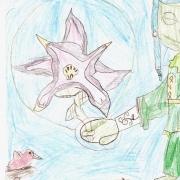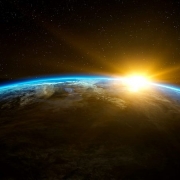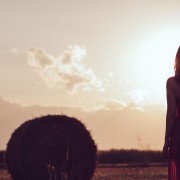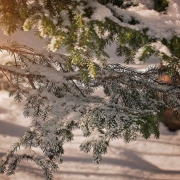The Old Gods, the Vanir and the Three Worlds
The Gods and Goddesses of Odinism
Copyright © 1996 The Circle of Ostara
Published with the kind permission of the Circle of Ostara.
This article must not be republished or reprinted
in whole or in part without their express written permission.
To our understanding the archaic divine forces who shaped the Living Stream when it first started flowing, continue still to shape it within the biological microcosm. The one-celled creatures and the cellular colonies which make up “higher” life forms are still controlled by these great (yet remote from us) spiritual beings and will be in their care as long as life continues on the Earth. Without their shaping hands the stuff of life would return to that unformed mass Ymir, for life itself is spirit working within this primal matter.
Bor and Bestla, our ancestors, called these great divinities, and saw them as, the parents of gods and men. In folklore and saga and in our mutilated mythology, we find hints of ancient attitudes, remnants of the old beliefs that saw the connection between plants and animals and divinity – that deer and wolves and trees have spirit guardians, a spirit world to which their ghosts fly when their material bodies perish.
We see the Earth as a multiversal sphere, three Worlds superimposed, that exist simultaneously. Not on three physical levels, although this idea is used as an explanatory diagram, but on three spiritual planes, the three worlds of Asgarth, Midgarth and Niflheim. Here in Midgarth the denizens of Asgarth and Niflheim are all about us, though our material sight has difficulty in discerning them.
The gods of nature move upon the Earth, though now, in this Dark Age, there are coming into being areas of the material World where the spirits of nature have withdrawn. In many plantations of alien conifers, for example, where the land is poisoned so that nothing else will grow. A strange phenomenon can be observed in these dreadful wastelands: the trees begin to change, the wood becomes spongy and pulpy, un-treelike, as if it was already dwindling back to the primal substance. The spirits of life have withdrawn from these plantations. Although growing, the trees are already dead, zombie trees without soul.
So it can be with mankind. We too live in great artificial plantations, monstrous cities housing ever-proliferating millions thrust together without concern for the real needs of the populations, either as races or as individuals – the spiritual needs that must be met if we are not to be overtaken by the fate of the conifer plantations. Already it seems that the gods of nature and race withdraw from our cities. We begin to lose compassion, to prey upon the old and the weak, to glorify disloyalty and perversity, to cast out love. Strange diseases arise, diseases which are not the result of the victim’s bodily resistance breaking down under overwhelming attack but are the result of the body’s defence system simply ceasing to function at all: the life force itself appears to withdraw, the will to live departs from the very cells of his flesh. Whilst still walking the Earth he begins to degenerate, to decay, to become the animated dead, even as the unfortunate trees.
The gods of nature and race are dishonoured and insulted by the very existence of these filthy cities. They begin to turn their backs upon our arrogance.
Who are the gods, the nature gods, the Old Vanir? Our ancestors must have known well these old gods of untamed nature, the gods of the wild woodland and uninhabited shores, and held them in awe. Little remains concerning them in our scraps of mythology. More frequent are references to those Vanes who were of particular significance to our ancient people: gods and goddesses of the sea and the fertile fields. These have become part of our racial pantheon and are considered in another article in this series. There are, however, enough hints in myth, saga and folktake to allow us to make a positive supposition that our ancestors saw the woods and meadows, the sacred springs, the river and lakes, the sea and the rushing air as being populated by a myriad spiritual beings, not all of them friendly.
Some of these spirits of the wild must resent the incursions of mankind, and the gods of mankind, into their untouched fastnesses. Our ancestors saw fairies and elves and giants all about them, spirits of hills and rocks, of mountains and headlands and deep-cut firths, of the fields they sowed and reaped and the pastures where their cattle grazed. Long ago, when our folk were hunters, they must have recognised the gods of the woodland and the deer, the gods of the valiant boar. They recognised the pixie on the hillside and the brownie who lived by the door, spirits of the hearth and the fire that burned in it, the nixie at the well, the elder-mother who cared for the garden and the hawthorn spirits who guarded the land’s boundary. Elves and fairies, hobgoblins and trolls – loved and feared but recognised. The gods of the countryside, great and small, who were part of our world until Christianity came and they said that the nature spirits went away. They didn’t, of course. We just stopped looking at them. It is only now that we who have returned to the old pagan belief begin to realise that under drastic provocation the spirits of nature can, indeed, withdraw from the World of Form.
The spirits of the Earth are as important to us in our existence as part of the stream of Earth life as the gods of our people are to us as a race. Without these wise old gods we would be denied material existence. We consider the myraid small spirits who live in trees and springs and the fire that burns on our hearth (if we have a hearth!) in another article. And elsewhere we will address ourselves to the question of the powerful deities of nature met with most frequently in old myth and saga disguised in the character of giants.





